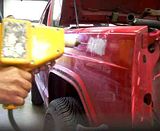Heres what I need to do.I want to be able to cut off the welding current while not stopping the wire feed...Mabee a foot control or something...what I want it to do is weld the wire to the metal then cut off the current while still feeding the wire out so the wire is welded to the metal then I can cut off the wire from the torch and use the wire to pull dents out...thereby eliminating the need for a stud welder...I need to know if a foot switch is what I want and if so where do I connect it..Is it even possible????
Any thoughts???
Any thoughts???





